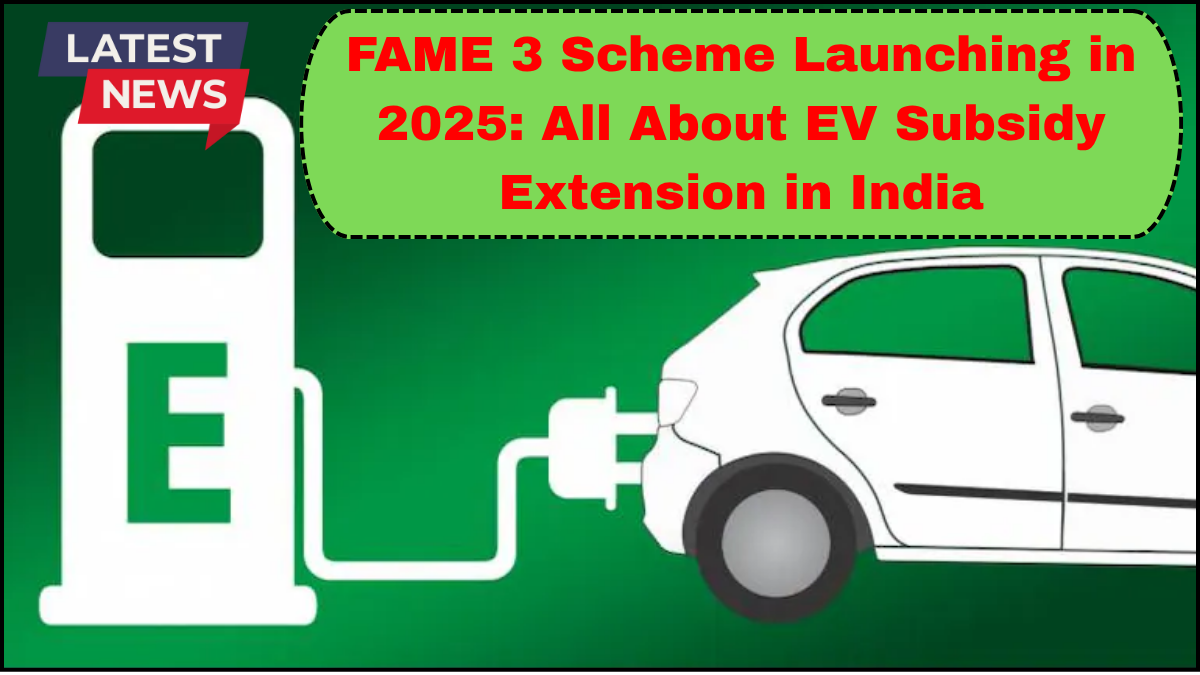India’s electric mobility landscape is on the verge of another major policy transformation. In a bold move to reinforce its commitment to green transportation, the Indian government is set to launch the FAME 3 scheme in 2025. This new phase aims to provide an EV subsidy extension in 2025, building on the momentum created by FAME 1 and FAME 2.

Let’s break down what this means for consumers, automakers, and India’s larger vision of a cleaner, sustainable transport ecosystem.
What is FAME?
FAME stands for Faster Adoption and Manufacturing of (Hybrid &) Electric Vehicles. Launched in 2015, the program is designed to promote electric mobility through financial incentives, infrastructure development, and R&D support.
-
FAME 1 (2015–2019): Focused on pilot projects and early adoption.
-
FAME 2 (2019–March 2024): Broadened the scope with higher outlays, focusing on electric two-wheelers, three-wheelers, electric buses, and commercial four-wheelers.
-
FAME 3 (Expected Launch: Early 2025): Will build on the previous successes and tackle remaining gaps in mass EV adoption.
Why the EV Subsidy Extension in 2025 Matters
The EV subsidy extension in 2025 through FAME 3 is critical for several reasons:
-
Bridging the Cost Gap
Despite falling battery costs, electric vehicles still carry a price premium over internal combustion engine (ICE) counterparts. Subsidies help close this affordability gap for everyday consumers. -
Accelerating Consumer Adoption
With rising fuel prices and urban pollution, demand for EVs is growing. However, many buyers still hesitate due to high upfront costs. Continued subsidies will nudge fence-sitters toward making the switch. -
Strengthening Domestic Manufacturing
By incentivizing locally made EVs and components, FAME 3 will further India’s “Make in India” and Atmanirbhar Bharat goals. This also reduces dependency on foreign suppliers, especially for batteries and semiconductors. -
Aligning with Net Zero Goals
India has pledged to achieve net-zero carbon emissions by 2070. A robust electric vehicle ecosystem plays a key role in meeting interim emission targets.
What to Expect in the India FAME 3 Scheme
While the final contours of the India FAME 3 scheme are still being finalized, early indications suggest a sharper focus and smarter incentive mechanisms:
a) Higher Outlay for Two- and Three-Wheelers
Electric two-wheelers account for over 60% of India’s EV sales. FAME 3 is expected to maintain or increase incentives in this segment while also bringing more unorganized fleet operators under the subsidy umbrella.
b) Focus on Public Transport and Fleets
Expect larger subsidies for electric buses and commercial fleets. Urban mobility programs will likely receive a boost, especially for Tier II and Tier III cities.
c) Better Charging Infrastructure Integration
FAME 3 may come bundled with complementary schemes to ramp up EV charging stations across highways, cities, and even residential complexes.
d) Stronger Checks Against Misuse
Previous schemes faced some criticism over misuse and inflated claims. FAME 3 is expected to introduce better compliance mechanisms, digital verification, and tighter audits.
Key Industries and Stakeholders Impacted
-
Automakers: EV startups like Ola Electric and Ather, along with giants like Tata Motors and Mahindra, stand to benefit the most from the subsidy extension.
-
Battery Manufacturers: Local battery pack assemblers and cell manufacturers will receive a stronger policy push.
-
Consumers: Price drops for EVs could become visible from mid-2025 onwards, depending on how quickly FAME 3 is rolled out.
EV Ecosystem Challenges FAME 3 Might Address
-
Range Anxiety: Through better charging infra and battery swapping solutions.
-
After-Sales Support: Incentives might be tied to ensuring longer warranties and robust service networks.
-
Skill Development: Support for training technicians in EV repairs and maintenance.
India’s Global Position in Electric Mobility
With FAME 3, India is signaling its intent to be a global leader in sustainable transport. The scheme is also expected to align with global trends—such as adopting solid-state batteries, faster charging technologies, and vehicle-to-grid (V2G) systems.
Countries like Norway and China have shown how effective policy support can drive mass EV adoption. India is taking a similar path but tailoring it to its unique challenges and demographics.
FAQs
Q1: What is the objective of the FAME 3 scheme?
A: The FAME 3 scheme aims to extend and expand EV subsidies in India, encourage local manufacturing, and accelerate the adoption of electric vehicles through financial and infrastructure support.
Q2: When will FAME 3 be launched?
A: FAME 3 is expected to be officially launched in early 2025, following the conclusion of FAME 2 in March 2024.
Q3: Will private car buyers benefit from FAME 3?
A: While FAME 2 limited incentives for private electric four-wheelers, FAME 3 may include select subsidies or tax reliefs depending on final policy decisions.
Q4: How long will the EV subsidy extension in 2025 last?
A: The extension is likely to cover a 3- to 5-year span, but the exact duration will be confirmed at the time of the policy rollout.
Q5: Will FAME 3 support battery swapping technology?
A: Yes, battery swapping is expected to be a key focus, especially for commercial vehicles and e-rickshaws to reduce downtime and operational costs.
click here to learn more



